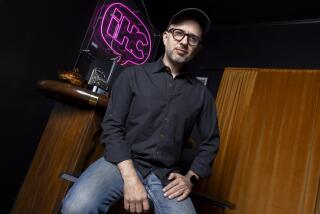Benefit Performance : Veterans Find Therapeutic Effect in Restoring a Theater on VA Grounds
- Share via
They probably aren’t talking about resurrected plays or recycled musicals when the subject of revivals comes up at one Los Angeles theater.
More likely than not Louis Zizza is explaining how an unexpected walk-on role has helped rescue him from war wounds he has suffered from for years. Nora Ward is telling how painted scenery has helped tame her schizophrenia. Martin Newman is relating how a decorated stage has restored vigor to his life.
The three are among patients at the West Los Angeles VA Medical Center who are benefiting from a treatment that has more to do with Thespians’ lines than with Hippocrates’ oath.
Nearly two dozen veterans have quietly turned an all-but-forgotten World War II assembly hall into the Westside’s newest legitimate theater.
To the surprise of all, the project seems to be restoring luster to lives as well as to walls.
Besides turning the 53-year-old auditorium into a theater, patients have lined up jobs selling concessions, directing theater traffic and shuttling theatergoers to and from parking lots. And as the first professional show--”Hello Muddah, Hello Faddah!”--is staged there, they are mapping ways to hook up with other productions.
Originally built to accommodate USO shows for wounded World War II soldiers and sailors, the Brentwood Theatre was just another anonymous building on the sprawling Wilshire Boulevard hospital grounds when patients volunteered two years ago to spruce it up.
Ward found herself working side-by-side with other patients as the theater’s drab, institutional paint job was covered over with a vibrant, gold-trimmed purple.
“It’s given me a place to go when I didn’t have another place to go,” said Ward, 35, a Navy veteran who said the experience has drawn her out of the shell she used to retreat into.
Zizza, who received back wounds in an Army tank explosion in Vietnam and later battled alcoholism at the hospital, was helping out backstage when he was tapped for a small role in the premiere show.
The rubber-faced West Los Angeles resident carries signs on stage between scenes. “Making people laugh is therapeutic,” said Zizza, 45.
Newman, a World War II Army veteran who became a medical center volunteer after being a patient there, crafted the gold-painted masks depicting comedy and tragedy that border the stage. He molded other face-like designs that line the auditorium’s seating area.
“Every one of us in our own way has benefited from working on this,” said Newman, 81, of Westwood. “To be truthful, it’s good therapy for my retirement years.”
It’s turned into good therapy for nearly everyone, said Dr. Edward Carroll, a Veterans Affairs psychologist.
“The patients here don’t have that many avenues to do something productive with their time,” Carroll said. “Most have chronic, lifelong ailments. They settle into a low-esteem sort of lifestyle.
“It doesn’t surprise me that when they’re doing something worthwhile they feel less depressed. It’s not necessarily going to cure schizophrenia. But pain is much less a part of their focus.”
VA officials credit back-injury patient Peter Roy with leading the restoration effort. They said the auditorium had an abandoned look when the 49-year-old Vietnam veteran caught his first glimpse of it.
“The walls were a horrible color. There was no sound system. Ceiling tiles were missing. Junk was stored along the sides of the auditorium and up on the stage,” said Jerry Johnson, the medical center’s chief of community resources.
*
The place was occasionally booked for small meetings, Johnson said. But it offered little for patients--most of whom now use the VA center on an outpatient basis.
Patients are getting free tickets to “Hello Muddah, Hello Faddah!,” a comedy that is halfway through its two-month run. Producer Michael Callan added 200 seats to boost the auditorium’s capacity to 512. He also installed a row of portable toilets outside the front door.
The shortage of restrooms, along with the absence of a lobby, are drawbacks, Callan said. So is the government red tape that has come with the $600-a-night lease.
“Now we’re trying to get toilet paper rolls put up in one of the bathrooms,” said co-producer Michele Martin. “You put in a requisition order and wait a few weeks.”
The veterans are convinced that that type of problem is also repairable.
The next phase of the theater renovation calls for replacement of existing seating with an elevated audience area. That will free room in the back for a lobby and new restrooms, Roy said.
Talks are underway with a developer interested in investing $600,000 for that construction in exchange for rights to manage the theater for the VA on a long-term basis, said Roy, a Buena Park resident who says his own work in the theater has caused him to all but forget about his lingering back ailment.
Profit from future theater rent will be plowed into veterans services at the center, he said. And veterans themselves will continue to have first crack at jobs such as ticket-taking, concession sales and parking.
“This could have a real impact,” Roy said.
“I’d say this has already saved some lives.”
More to Read
The biggest entertainment stories
Get our big stories about Hollywood, film, television, music, arts, culture and more right in your inbox as soon as they publish.
You may occasionally receive promotional content from the Los Angeles Times.











